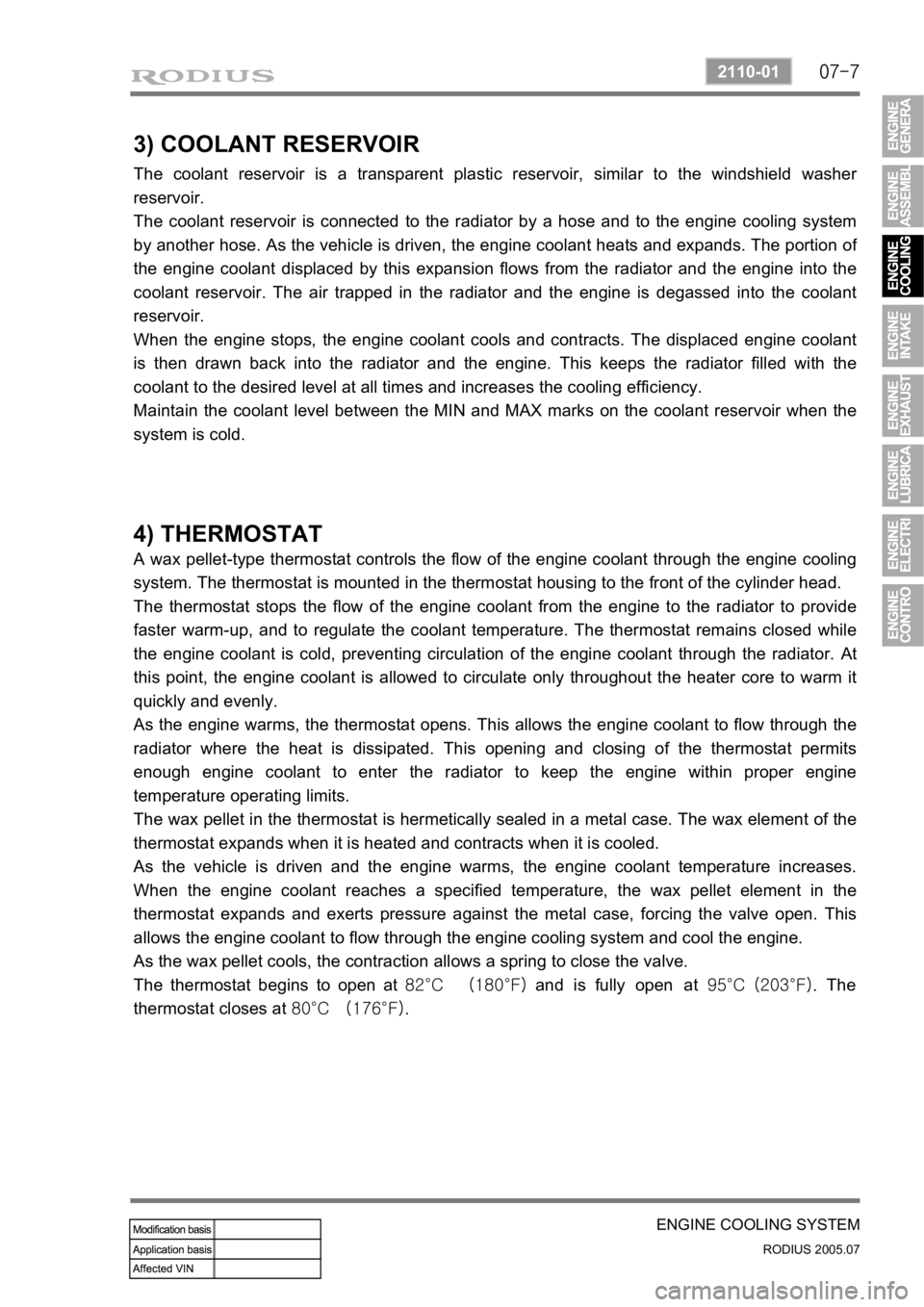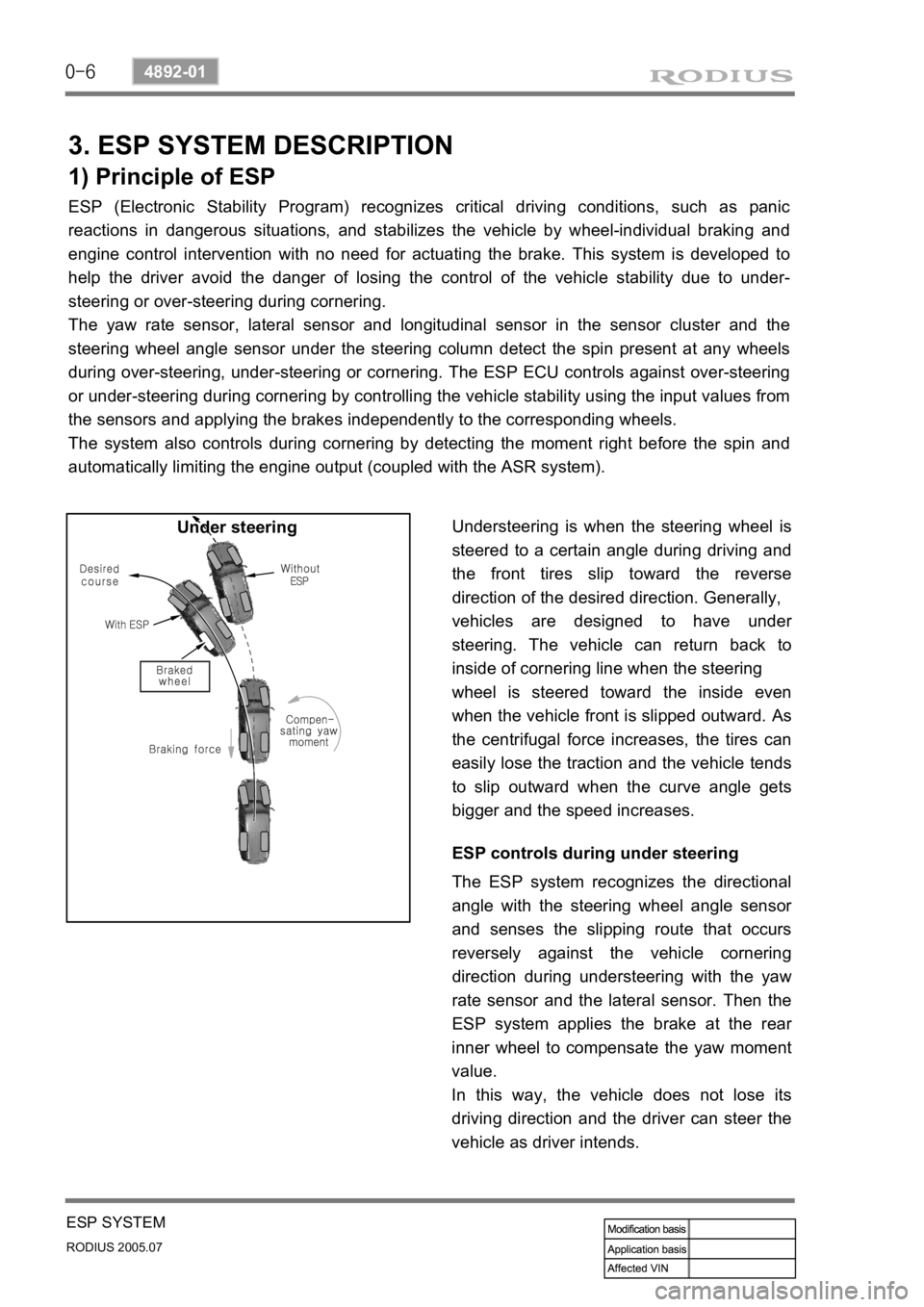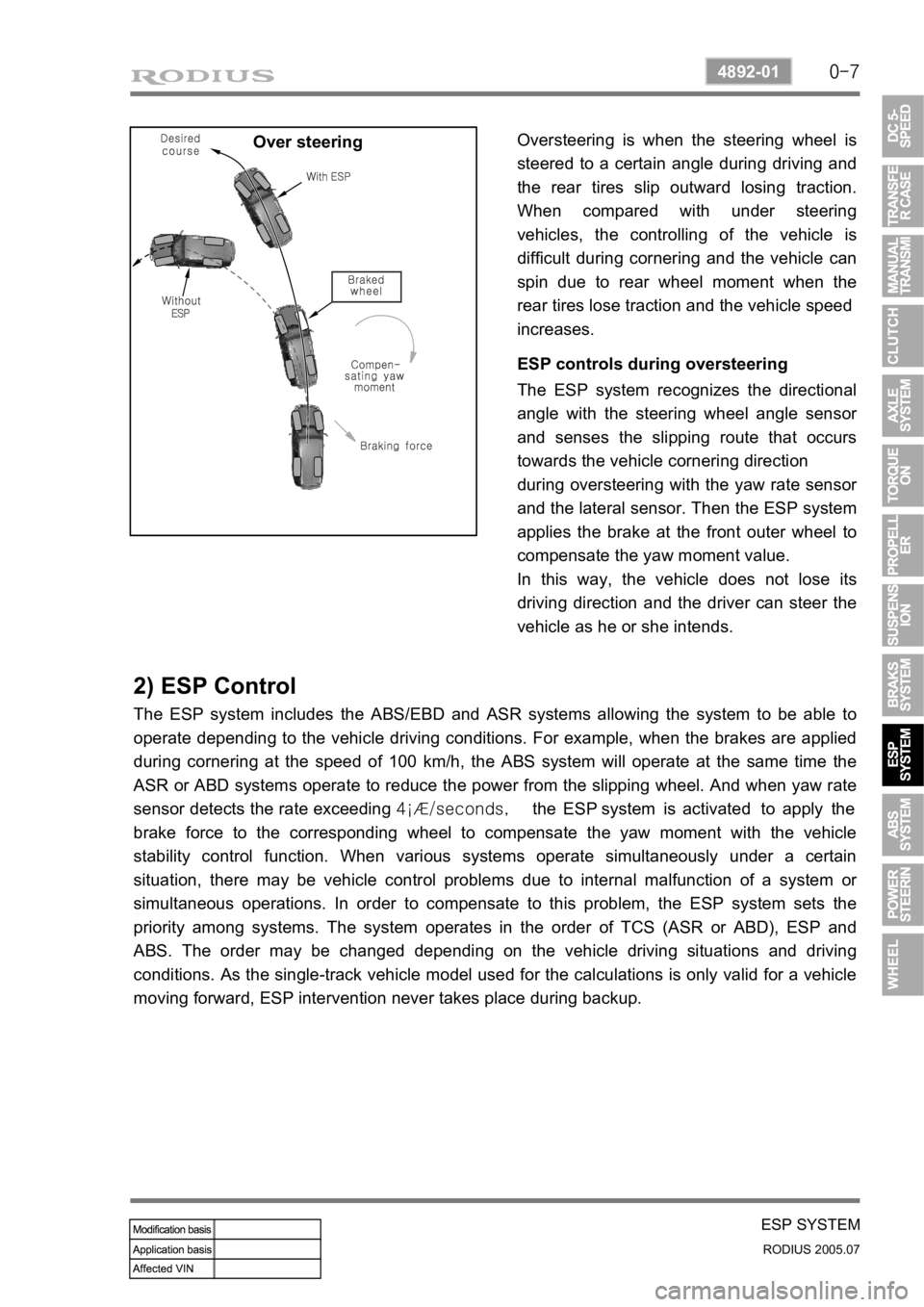traction control SSANGYONG RODIUS 2005 Service Manual
[x] Cancel search | Manufacturer: SSANGYONG, Model Year: 2005, Model line: RODIUS, Model: SSANGYONG RODIUS 2005Pages: 502, PDF Size: 70.43 MB
Page 123 of 502

07-7
ENGINE COOLING SYSTEM
RODIUS 2005.07
2110-01
3) COOLANT RESERVOIR
The coolant reservoir is a transparent plastic reservoir, similar to the windshield washer
reservoir.
The coolant reservoir is connected to the radiator by a hose and to the engine cooling system
by another hose. As the vehicle is driven, the engine coolant heats and expands. The portion o
f
the engine coolant displaced by this expansion flows from the radiator and the engine into the
coolant reservoir. The air trapped in the radiator and the engine is degassed into the coolant
reservoir.
When the engine stops, the engine coolant cools and contracts. The displaced engine coolant
is then drawn back into the radiator and the engine. This keeps the radiator filled with the
coolant to the desired level at all times and increases the cooling efficiency.
Maintain the coolant level between the MIN and MAX marks on the coolant reservoir when the
system is cold.
4) THERMOSTAT
A wax pellet-type thermostat controls the flow of the engine coolant through the engine cooling
system. The thermostat is mounted in the thermostat housing to the front of the cylinder head.
The thermostat stops the flow of the engine coolant from the engine to the radiator to provide
faster warm-up, and to regulate the coolant temperature. The thermostat remains closed while
the engine coolant is cold, preventing circulation of the engine coolant through the radiator.
At
this point, the engine coolant is allowed to circulate only throughout the heater core to warm it
quickly and evenly.
As the engine warms, the thermostat opens. This allows the engine coolant to flow through the
radiator where the heat is dissipated. This opening and closing of the thermostat permits
enough engine coolant to enter the radiator to keep the engine within proper engine
temperature operating limits.
The wax pellet in the thermostat is hermetically sealed in a metal case. The wax element of the
thermostat expands when it is heated and contracts when it is cooled.
As the vehicle is driven and the engine warms, the engine coolant temperature increases.
When the engine coolant reaches a specified temperature, the wax pellet element in the
thermostat expands and exerts pressure against the metal case, forcing the valve open. This
allows the engine coolant to flow through the engine cooling system and cool the engine.
As the wax pellet cools, the contraction allows a spring to close the valve.
The thermostat begins to open at 82°C (180°F) and is fully open at 95°C (203°F). The
thermostat closes at 80°C (176°F).
Page 239 of 502

0-6
RODIUS 2005.07
4892-01
ESP SYSTEM
3. ESP SYSTEM DESCRIPTION
1) Principle of ESP
ESP (Electronic Stability Program) recognizes critical driving conditions, such as panic
reactions in dangerous situations, and stabilizes the vehicle by wheel-individual braking and
engine control intervention with no need for actuating the brake. This system is developed to
help the driver avoid the danger of losing the control of the vehicle stability due to under-
steering or over-steering during cornering.
The yaw rate sensor, lateral sensor and longitudinal sensor in the sensor cluster and the
steering wheel angle sensor under the steering column detect the spin present at any wheels
during over-steering, under-steering or cornering. The ESP ECU controls against over-steering
or under-steering during cornering by controlling the vehicle stability using the input values from
the sensors and applying the brakes independently to the corresponding wheels.
The system also controls during cornering by detecting the moment right before the spin and
automatically limiting the engine output (coupled with the ASR system).
Understeering is when the steering wheel is
steered to a certain angle during driving and
the front tires slip toward the reverse
direction of the desired direction. Generally,
vehicles are designed to have unde
r
steering. The vehicle can return back to
inside of cornering line when the steering
wheel is steered toward the inside even
when the vehicle front is slipped outward.
As
the centrifugal force increases, the tires can
easily lose the traction and the vehicle tends
to slip outward when the curve angle gets
bigger and the speed increases. Under steering
ESP controls during under steering
The ESP system recognizes the directional
angle with the steering wheel angle senso
r
and senses the slipping route that occurs
reversely against the vehicle cornering
direction during understeering with the yaw
rate sensor and the lateral sensor. Then the
ESP system applies the brake at the rea
r
inner wheel to compensate the yaw moment
value.
In this way, the vehicle does not lose its
driving direction and the driver can steer the
vehicle as driver intends.
Page 240 of 502

0-7
ESP SYSTEM
RODIUS 2005.07
4892-01
Over steeringOversteering is when the steering wheel is
steered to a certain angle during driving and
the rear tires slip outward losing traction.
When compared with under steering
vehicles, the controlling of the vehicle is
difficult during cornering and the vehicle can
spin due to rear wheel moment when the
rear tires lose traction and the vehicle speed
increases.
ESP controls during oversteering
The ESP system recognizes the directional
angle with the steering wheel angle senso
r
and senses the slipping route that occurs
towards the vehicle cornering direction
during oversteering with the yaw rate senso
r
and the lateral sensor. Then the ESP system
applies the brake at the front outer wheel to
compensate the yaw moment value.
In this way, the vehicle does not lose its
driving direction and the driver can steer the
vehicle as he or she intends.
2) ESP Control
The ESP system includes the ABS/EBD and ASR systems allowing the system to be able to
operate depending to the vehicle driving conditions. For example, when the brakes are applied
during cornering at the speed of 100 km/h, the ABS system will operate at the same time the
ASR or ABD systems operate to reduce the power from the slipping wheel. And when yaw rate
sensor detects the rate exceeding 4¡Æ/seconds, the ESP system is activated to apply the
brake force to the corresponding wheel to compensate the yaw moment with the vehicle
stability control function. When various systems operate simultaneously under a certain
situation, there may be vehicle control problems due to internal malfunction of a system o
r
simultaneous operations. In order to compensate to this problem, the ESP system sets the
priority among systems. The system operates in the order of TCS (ASR or ABD), ESP and
ABS. The order may be changed depending on the vehicle driving situations and driving
conditions. As the single-track vehicle model used for the calculations is only valid for a vehicle
moving forward, ESP intervention never takes place during backup.